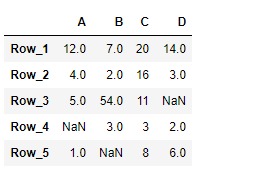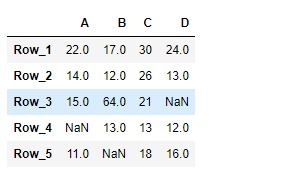Pandas DataFrame是带有标签轴(行和列)的二维大小可变的,可能是异构的表格数据结构。算术运算在行和列标签上对齐。可以将其视为Series对象的dict-like容器。这是 Pandas 的主要数据结构。
Pandas DataFrame.transform()self上的函数调用func会生成具有转换后的值且具有与self相同的轴长的DataFrame。
用法: DataFrame.transform(func, axis=0, *args, **kwargs)
参数:
func:用于转换数据的函数
axis:{0或“索引”,1或“列”},默认0
*args:位置参数传递给func。
**kwargs:传递给func的关键字参数。
返回: DataFrame
范例1:采用DataFrame.transform()函数将10添加到 DataFrame 中的每个元素。
# importing pandas as pd
import pandas as pd
# Creating the DataFrame
df = pd.DataFrame({"A":[12, 4, 5, None, 1],
"B":[7, 2, 54, 3, None],
"C":[20, 16, 11, 3, 8],
"D":[14, 3, None, 2, 6]})
# Create the index
index_ = ['Row_1', 'Row_2', 'Row_3', 'Row_4', 'Row_5']
# Set the index
df.index = index_
# Print the DataFrame
print(df)输出:

现在我们将使用DataFrame.transform()函数将10添加到数据帧的每个元素。
# add 10 to each element of the dataframe
result = df.transform(func = lambda x:x + 10)
# Print the result
print(result)输出:

正如我们在输出中看到的,DataFrame.transform()函数已成功将10添加到给定Dataframe的每个元素中。
范例2:采用DataFrame.transform()函数来求平方根,并将欧拉数的结果提升到 DataFrame 的每个元素。
# importing pandas as pd
import pandas as pd
# Creating the DataFrame
df = pd.DataFrame({"A":[12, 4, 5, None, 1],
"B":[7, 2, 54, 3, None],
"C":[20, 16, 11, 3, 8],
"D":[14, 3, None, 2, 6]})
# Create the index
index_ = ['Row_1', 'Row_2', 'Row_3', 'Row_4', 'Row_5']
# Set the index
df.index = index_
# Print the DataFrame
print(df)输出:

现在我们将使用DataFrame.transform()函数来求平方根,并将欧拉数的结果提升到 DataFrame 的每个元素。
# pass a list of functions
result = df.transform(func = ['sqrt', 'exp'])
# Print the result
print(result)输出:

正如我们在输出中看到的,DataFrame.transform()函数已成功在给定的数据帧上执行了所需的操作。
相关用法
- Python pandas.map()用法及代码示例
- Python Pandas Series.str.len()用法及代码示例
- Python Pandas.factorize()用法及代码示例
- Python Pandas TimedeltaIndex.name用法及代码示例
- Python Pandas dataframe.ne()用法及代码示例
- Python Pandas Series.between()用法及代码示例
- Python Pandas DataFrame.where()用法及代码示例
- Python Pandas Series.add()用法及代码示例
- Python Pandas.pivot_table()用法及代码示例
- Python Pandas Series.mod()用法及代码示例
- Python Pandas Dataframe.at[ ]用法及代码示例
- Python Pandas Dataframe.iat[ ]用法及代码示例
- Python Pandas.pivot()用法及代码示例
- Python Pandas dataframe.mul()用法及代码示例
- Python Pandas.melt()用法及代码示例
注:本文由纯净天空筛选整理自Shubham__Ranjan大神的英文原创作品 Python | Pandas DataFrame.transform。非经特殊声明,原始代码版权归原作者所有,本译文未经允许或授权,请勿转载或复制。
